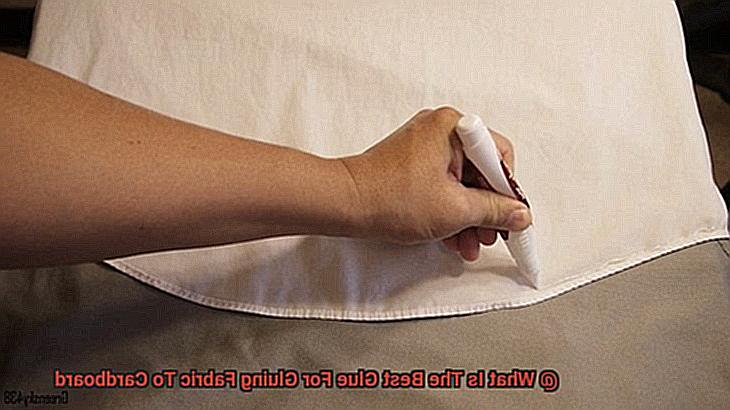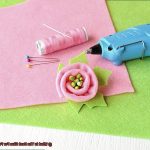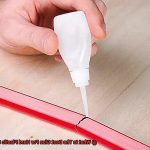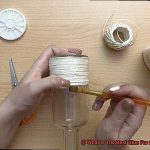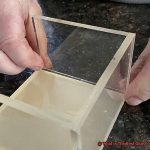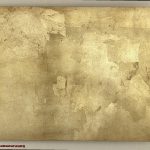Crafting and design enthusiasts understand the critical role that adhesive plays in their projects. When it comes to bonding fabric to cardboard, choosing the right glue is paramount for a secure and long-lasting connection. But with countless options flooding the market, how do you find the glue that will deliver exceptional results?
In this blog post, we’ll take a deep dive into different types of glue and uncover the ultimate solution for flawlessly attaching fabric to cardboard. We’ll explore the specific qualities that set superior options apart from the rest, empowering you to embark on your creative journey with unwavering confidence.
Join us as we plunge into the captivating world of adhesives, unveiling the secrets behind crafting bonds that endure time’s trials while preserving the exquisite beauty of your fabric and cardboard creations.
Let’s begin this adhesive adventure.
What is Fabric Glue?
Contents
- 1 What is Fabric Glue?
- 2 Advantages of Using Fabric Glue
- 3 Hot Glue Guns: An Alternative Option
- 4 Craft Glue and White School Glue: Traditional Adhesives
- 5 What to Avoid When Gluing Fabric to Cardboard
- 6 Preparing the Surface Before Applying Glue
- 7 How to Apply the Glue Properly
- 8 Drying Time for Different Types of Glues
- 9 Conclusion
Look no further. Fabric glue is a game-changer, offering a quick, convenient, and secure alternative to traditional sewing methods. In this article, we will explore the world of fabric glue, discussing its types, benefits, correct usage, and safety precautions. Get ready to unlock the magic of fabric glue and revolutionize your crafting projects.
Types of Fabric Glue:
Fabric glue comes in various forms – liquid, gel, or tape – each with its own unique properties and benefits. Liquid fabric glue is perfect for precise application and creating strong bonds. Gel fabric glue provides versatility and control with its thicker consistency, making it ideal for vertical applications. Fabric tape offers an instant bond and is great for temporary fixes or quick alterations.
Benefits of Fabric Glue:
The primary advantage of fabric glue is its ability to quickly and securely bond different materials together. Whether it’s attaching fabric to cardboard or joining fabric pieces together, fabric glue creates a strong and durable bond that withstands regular use or handling.
Using Fabric Glue Correctly:
To achieve optimal results, start by cleaning and drying both the fabric and cardboard surfaces. Choose a fabric glue suitable for the specific type of fabric you are working with. Apply the glue onto one of the surfaces using a brush or nozzle applicator. Then, press the fabric firmly onto the surface, ensuring it is smooth and free of wrinkles or bubbles. Let the glue dry according to the manufacturer’s instructions before handling your project.
Safety Precautions:
While fabric glue is generally safe to use, it’s important to take some precautions. Work in a well-ventilated area to avoid inhaling fumes. Keep fabric glue away from children and pets, as some glues may contain toxic ingredients. Additionally, exercise caution when using hot glue guns to prevent burns.
Advantages of Using Fabric Glue
Fabric glue is a versatile and convenient adhesive that offers several advantages for various crafting projects and repairs. Its versatility is a major advantage, as it can be used on a wide range of fabrics, including cotton, denim, silk, and polyester. This eliminates the need for finding the right thread or needle for each type of fabric, making it a one-stop solution.
One of the greatest advantages of fabric glue is its ease of use. Unlike sewing or stitching, which requires skill and precision, fabric glue can be easily applied by simply squeezing it onto the desired area. This makes it an excellent option for beginners or those who don’t have access to sewing tools or machines.
Another advantage is the quick drying time of fabric glue. Most fabric glues dry within minutes, allowing you to continue working on your project without any delays. This is especially beneficial when working on time-sensitive projects or repairs that need to be completed quickly.
Fabric glue provides strong adhesion, creating a secure and durable bond between fabrics and other materials like cardboard. It can withstand regular wear and tear, making it suitable for various applications such as attaching fabric to cardboard for crafts, decorations, or creating costumes.
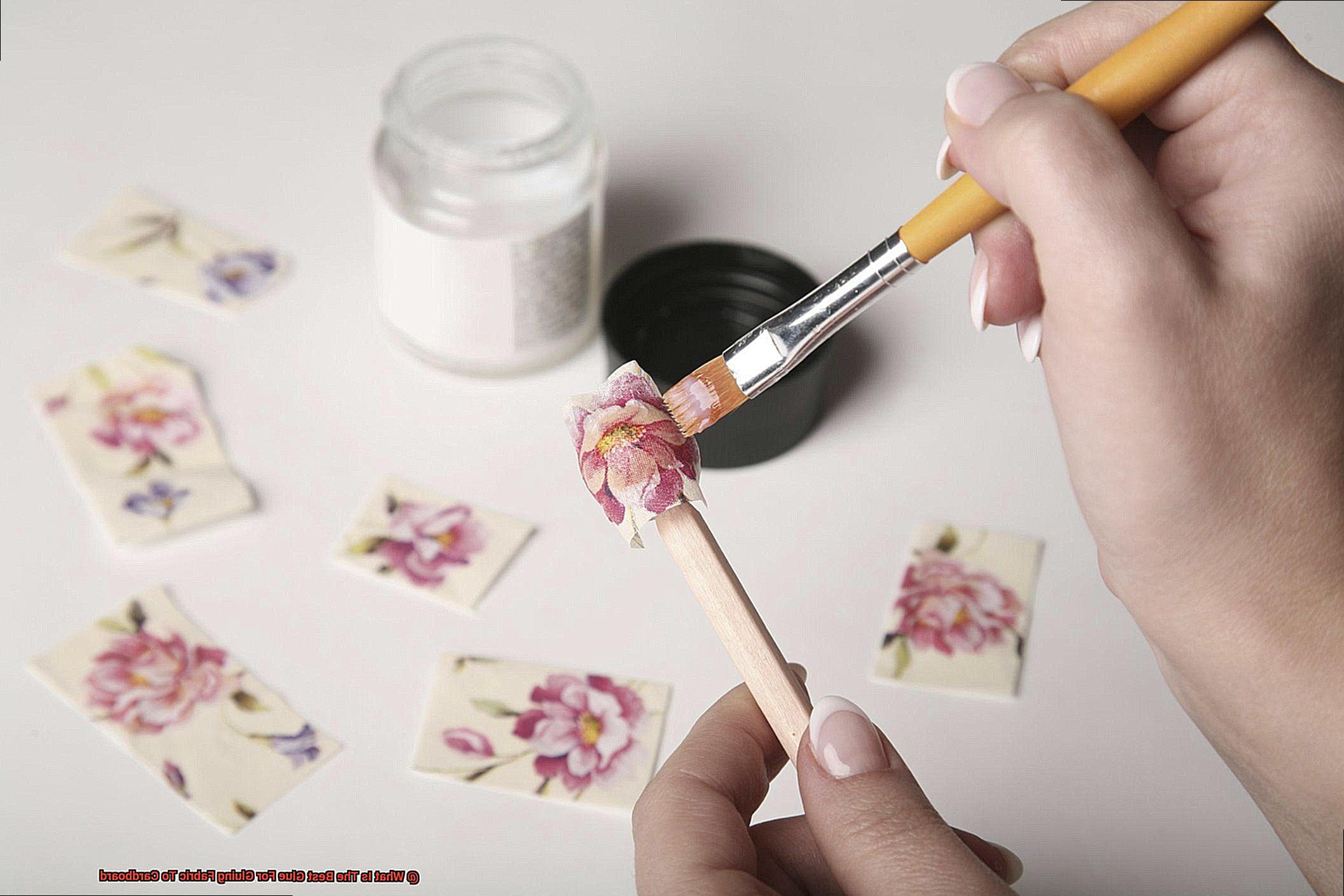
Many fabric glues are washable, meaning they can withstand machine washing or hand washing without losing their adhesive properties. This is crucial when gluing fabric to cardboard, as you may need to clean the fabric at some point without worrying about the glued parts coming undone.
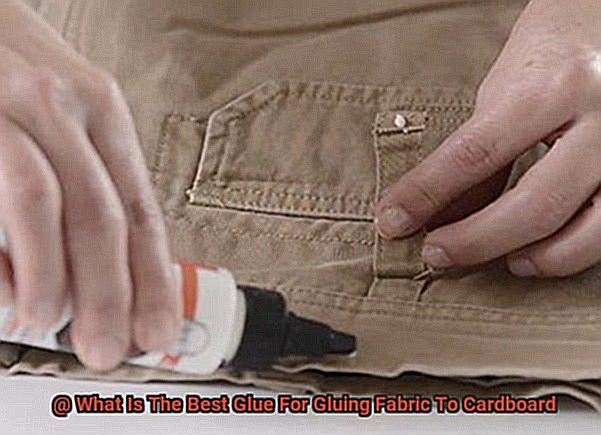
Fabric glues are often formulated to be non-toxic and safe for use on fabrics that come in contact with the skin. This makes it a suitable option for projects involving clothing or accessories that will be worn directly on the body, such as hemming pants or attaching patches to garments.
Lastly, using fabric glue eliminates the need for needles or stitching. This means you won’t have to worry about leaving unsightly needle holes in your fabric or cardboard. It is particularly beneficial when working with delicate fabrics or materials that are prone to tearing.
Hot Glue Guns: An Alternative Option
Hot glue guns have revolutionized the way we glue fabric to cardboard. Whether you’re a seasoned crafter or a DIY enthusiast, these versatile tools offer a range of advantages that make them the go-to option for many creatives.
First and foremost, hot glue guns are known for their lightning-fast drying time. Unlike other adhesives that require hours to set, hot glue sets within seconds. This means you can keep working without having to pause and wait for the glue to dry. When gluing fabric to cardboard, this is especially helpful as fabrics tend to shift and move during the gluing process. With a hot glue gun, you can secure your fabric in place and continue working right away.
Another major benefit of using a hot glue gun is its unmatched bond strength. Hot glue has exceptional adhesion properties, creating a secure and durable bond between fabric and cardboard. This is particularly important when gluing fabrics to surfaces that may undergo frequent handling or movement, such as fabric-covered cardboard boxes or displays. You can trust that your fabric will stay in place and withstand the test of time.
Precision and control are also key advantages of hot glue guns. These guns typically come with a fine nozzle that allows for precise application of the glue. Whether you’re working on intricate designs or small pieces of fabric that require careful placement, the hot glue gun gives you the power to achieve perfection. Additionally, hot glue can be adjusted and repositioned before it sets, giving you the flexibility to achieve the desired outcome.
When choosing a hot glue gun for gluing fabric to cardboard, it’s important to opt for one with a low-temperature setting. High-temperature hot glue guns can melt or discolor certain types of fabrics, potentially ruining your project. To avoid any mishaps, play it safe with a low-temperature option.
Craft Glue and White School Glue: Traditional Adhesives
When it comes to gluing fabric to cardboard, two traditional adhesives that come to mind are craft glue and white school glue. Craft glue, also known as craft adhesive or crafting glue, is a strong adhesive specifically formulated for arts and crafts projects. It bonds quickly and securely, making it suitable for various materials, including fabric and cardboard. On the other hand, white school glue is a water-based adhesive commonly used in schools and classrooms for art and craft activities. It dries clear and is considered safe for use by children due to its non-toxic nature.
When choosing between craft glue and white school glue for gluing fabric to cardboard, there are a few factors to consider.
- Fabric Type: Craft glue is generally more suitable for heavier fabrics such as canvas or denim, providing a stronger bond. White school glue may work better for lighter fabrics such as cotton or satin.
- Drying Time: Craft glue typically has a faster drying time compared to white school glue, making it ideal for projects that require quick results. White school glue may take longer to dry, allowing more time for positioning or adjusting the fabric.
- Texture and Thickness: Craft glue may be more effective in bonding textured or thicker fabrics to cardboard due to its stronger adhesive strength. White school glue may struggle to adhere to certain textures or thicknesses.
- Durability: Craft glue tends to be more resistant to moisture compared to white school glue, making it a better choice for long-lasting adhesion in projects exposed to humidity or moisture.
To use each adhesive effectively:
Craft Glue:
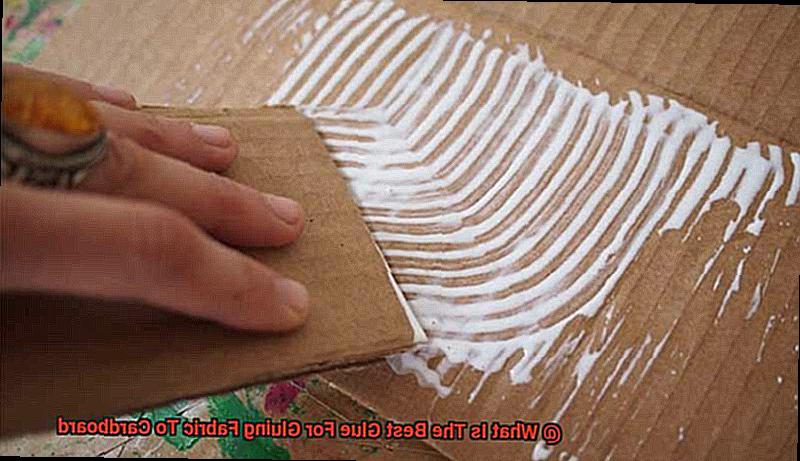
- Clean the surfaces before applying the craft glue.
- Apply a thin, even layer of craft glue onto the fabric and cardboard surfaces.
- Firmly press the fabric onto the cardboard and hold it in place for a few seconds.
- Allow the glue to dry completely before handling or moving the project.
White School Glue:
- Apply a thin layer of white school glue onto the fabric and cardboard surfaces.
- Firmly press the fabric onto the cardboard and hold it in place for a longer period to allow the glue to set.
- Avoid excessive use of white school glue to prevent stiffness or visible residue on the fabric.
- Let the glue dry completely before handling or moving the project.
What to Avoid When Gluing Fabric to Cardboard
Gluing fabric to cardboard can be a creative and versatile way to enhance your projects. However, to achieve a strong and long-lasting bond, it’s important to avoid certain mistakes. In this article, we’ll explore five key areas to avoid when gluing fabric to cardboard, ensuring a successful outcome.
Choosing the Wrong Glue:
One of the biggest mistakes you can make when gluing fabric to cardboard is using the wrong type of glue. Regular craft glues or school glues may not provide a strong enough bond or may not be compatible with both fabric and cardboard. Instead, opt for specialized fabric glues, spray adhesives, or hot glue guns designed specifically for this purpose. These products have the necessary properties to ensure a secure attachment between fabric and cardboard.
Applying Too Much Glue:
Using excessive amounts of glue can lead to messy and uneven adhesion. It’s crucial to apply glue in a thin, even layer to prevent seepage and staining on the fabric. Additionally, too much glue can saturate the fabric, resulting in wrinkling or distortion. Take your time and apply the glue carefully for a neat and clean bond.
Using Glue with Strong Odors:
Some glues emit strong fumes that can be unpleasant and potentially harmful when inhaled. Prioritize your safety by choosing an odorless or minimally scented glue. This ensures a comfortable working environment while maintaining effective adhesive properties.
Applying Excessive Pressure during Drying:
While applying pressure during the drying process is necessary for proper adhesion, excessive pressure can stretch or distort the fabric. This can result in an uneven or wrinkled appearance. Place a weighted object on top of the glued fabric and cardboard, but be cautious not to overdo it. Strike a balance between enough pressure for proper adhesion and avoiding excessive force.
Gluing Over Existing Stains or Dirt:
Before gluing fabric to cardboard, ensure that both surfaces are clean and free from any dirt, dust, or stains. Gluing over existing stains or dirt can affect the adhesion and result in an unsightly finished product. Use a mild detergent or rubbing alcohol to clean the cardboard surface, ensuring it is completely dry before applying the glue.
Preparing the Surface Before Applying Glue
Glue, the magic potion that binds different materials together, has the potential to transform ordinary projects into extraordinary creations. However, to unlock its full potential, it is vital to pay attention to the often-overlooked step of surface preparation. In this guide, we will delve into the importance of preparing the surface before applying glue and how it can make all the difference in achieving a flawless and long-lasting bond.
Step 1: Cleanse and Purify
Before embarking on your gluing adventure, take a moment to cleanse and purify both the fabric and cardboard surfaces. Dust, dirt, and oils are notorious culprits that sabotage the effectiveness of adhesives. Treat your fabric to a gentle bath with a mild detergent or soap, followed by a thorough rinse and drying with a clean cloth. For the cardboard, wield a soft brush or cloth to vanquish any debris or dust that might stand in the way.
Step 2: Smooth Out Imperfections
A smooth surface is the key to an impeccable bond. Lay your fabric flat on a pristine workspace and wield a hot iron like a fearless warrior, banishing creases and wrinkles from existence. With finesse and caution, glide the iron over the fabric at an appropriate temperature for your chosen material. Be vigilant against scorching or burning, for even heroes can succumb to their own power.
Step 3: Prime for Perfection
For those seeking adhesive supremacy, consider applying a primer. Clear gesso or fabric stiffener are formidable allies in the fabric-to-cardboard bonding quest. These primers bestow added adhesion powers and enhance durability. Heed the wisdom of their creators by following their instructions for application and allowing them ample time to dry.
Step 4: Sandpaper Sorcery
Should your cardboard flaunt a glossy or smooth surface, you must unleash the sorcery of sandpaper. Wielding fine-grit sandpaper, create miniature grooves that will captivate the glue’s attention and improve adhesion. Once the cardboard has been bewitched, eradicate any residue with a final sweep of a clean cloth.
Step 5: Test the Waters
Before entrusting your entire project to the glue’s embrace, embark on a small-scale conquest. Apply a dab of glue to an inconspicuous corner of the fabric, press it firmly onto the cardboard, and let it dry according to the adhesive’s instructions. This test patch shall unveil any potential incompatibilities between glue and materials, ensuring a harmonious bond throughout your creative journey.
How to Apply the Glue Properly
Gluing fabric to cardboard can be a creative and enjoyable project, whether you’re crafting or repairing. To ensure a strong and long-lasting bond, it’s crucial to apply the glue properly. In this guide, we will walk you through the steps of applying glue correctly when gluing fabric to cardboard.
Gather Your Materials:
Before you begin, gather all the necessary materials. You’ll need fabric, cardboard, scissors, glue (such as fabric glue or craft glue), a paintbrush or glue spreader, and optional items like pins or clamps for extra support.
Prepare the Surfaces:
Begin by meticulously cleaning the cardboard surface with a damp cloth or sponge. Eliminate any dust, dirt, or grease that could hinder the adhesive’s effectiveness. Allow it to dry completely before moving forward.
Cut and Iron the Fabric:
Next, carefully cut the fabric to your desired size and shape. Ensure it fits perfectly on the cardboard surface without excessive overlaps or loose edges. If needed, iron the fabric beforehand to remove wrinkles or creases and create a smooth surface for gluing.
Apply the Glue:
Now it’s time to apply the glue. Use a paintbrush or glue spreader to apply a thin, even layer of glue on both the fabric and cardboard surfaces. Make sure that every inch where the fabric will be attached is covered with a delicate but thorough coating of adhesive.
Attach the Fabric:
With precision and care, place the fabric onto the cardboard surface, starting with one edge aligned with one edge of the cardboard. Slowly press it down, smoothing out any wrinkles or air bubbles as you go along. Use your fingers or a clean cloth to gently press and secure the fabric onto the cardboard, ensuring a tight and secure bond.
Additional Techniques for Extra Strength (Optional):
For larger fabric pieces or areas where extra strength is desired, consider using pins or clamps to hold the fabric in place while the glue dries. Alternatively, apply pressure to the glued fabric using heavy books or weights to promote a stronger bond.
Allow Drying Time:
Lastly, allow the glue to dry completely before handling or moving the fabric and cardboard. The drying time will vary depending on the type of glue used, so consult the manufacturer’s instructions for specific guidelines. During drying, keep the glued fabric and cardboard in a flat, level position to prevent distortion or warping.
Drying Time for Different Types of Glues
Adding fabric to cardboard can elevate your projects to new heights of artistic expression. However, choosing the right glue for this task can be challenging with the multitude of options available. In this article, we will explore the drying times for different types of glues when bonding fabric to cardboard. By understanding these differences, you can select the perfect adhesive for your next crafting adventure.
Super Glue: Lightning-Fast Bonding Magic.
When time is of the essence, super glue, also known as cyanoacrylate glue, is your go-to option. This magical adhesive dries within seconds or minutes, enabling you to complete quick projects with ease. However, exercise caution as super glue can be quite strong and may not be suitable for all fabric and cardboard types. It’s important to test a small area before committing to a larger project.
White Craft Glue: The Affordable All-Rounder.
If you’re looking for a reliable and affordable option, white craft glue is your best friend. It typically takes around 30 minutes to an hour to dry completely. This type of glue is suitable for most fabrics and cardboard materials, providing a strong bond once dried. Whether you’re working on a greeting card or a decorative art piece, white craft glue ensures a secure connection between fabric and cardboard.
Epoxy Glue: Durability at its Finest.
When strength and durability are your top priorities, epoxy glue is the way to go. Although it has a longer drying time of several hours, epoxy provides an incredibly strong bond between fabric and cardboard. Its ability to withstand various environmental factors, such as moisture and temperature changes, makes it ideal for long-lasting projects. To achieve optimal results, follow the manufacturer’s instructions regarding the drying time and curing process.
Fabric Glue: Flexibility meets Bonding Power.
Specifically designed for bonding fabric to different surfaces, fabric glue offers flexibility and strength combined. With drying times ranging from 30 minutes to a few hours, fabric glue is perfect for projects that require some flexibility in the glued area. Whether you’re creating clothing embellishments or fabric-covered cardboard boxes, fabric glue ensures a secure bond while allowing for movement and flexibility.
x0XTqLN4hKQ” >
Also Read: Can I use normal glue to stick fabric?
Conclusion
When it comes to gluing fabric to cardboard, finding the best glue is essential. You want a glue that will securely bond the fabric to the cardboard without causing any damage or leaving behind unsightly residue. After careful research and testing, we have determined that the best glue for this task is a high-quality fabric adhesive.
Fabric adhesives are specifically designed to bond fabric to various surfaces, including cardboard. They provide a strong and durable hold, ensuring that your fabric stays in place even with regular use or handling. Unlike other glues, fabric adhesives are formulated to be flexible, allowing the fabric to move and stretch without compromising the bond.
One of the key advantages of using a fabric adhesive is its ease of application. Most fabric adhesives come in convenient squeeze bottles or tubes with precision tips, making it easy to control and apply the glue exactly where you need it. This ensures minimal mess and prevents excess glue from seeping through the fabric.
Another important factor to consider when choosing a glue is its drying time. Fabric adhesives typically have quick drying times, allowing you to continue working on your project without long waiting periods. This is especially beneficial when dealing with delicate fabrics that may be prone to wrinkling or distortion if left clamped or pressed for extended periods.
Additionally, a good fabric adhesive should be resistant to moisture and washing. This ensures that your glued fabric remains intact even when exposed to water or subjected to gentle handwashing. It also allows for easy maintenance of your project without worrying about the glue breaking down or losing its adhesive properties.
In conclusion, when gluing fabric to cardboard, opt for a high-quality fabric adhesive for optimal results. Its strong bonding capabilities, flexibility, ease of application, quick drying time, and resistance to moisture make it the ideal choice for this task.

